Post-Operative Nursing Care: Assessment, Interventions, and Evaluation
VerifiedAdded on 2022/10/19
|9
|2636
|163
Report
AI Summary
This report provides a comprehensive overview of post-operative nursing care, focusing on the case of Mrs. Carey, a patient who underwent a cholesystectomy. The nursing process, encompassing assessment, diagnosis, planning, intervention, and evaluation, is applied throughout. High-priority nursing interventions discussed include airway management, pain assessment and management (including pharmacological and non-pharmacological approaches), fluid and electrolyte balance, and prevention of surgical wound infection. The report details the assessment plan, nursing interventions, and evaluation of outcomes for each priority problem. It also covers the administration and nursing considerations for Fentanyl PCA and Cephazolin. Patient education regarding wound care, medication, diet, exercise, and follow-up is emphasized, adhering to the Nursing and Midwifery Board of Australia's standards. The report concludes with a summary of key findings and the importance of family-centered nursing care.
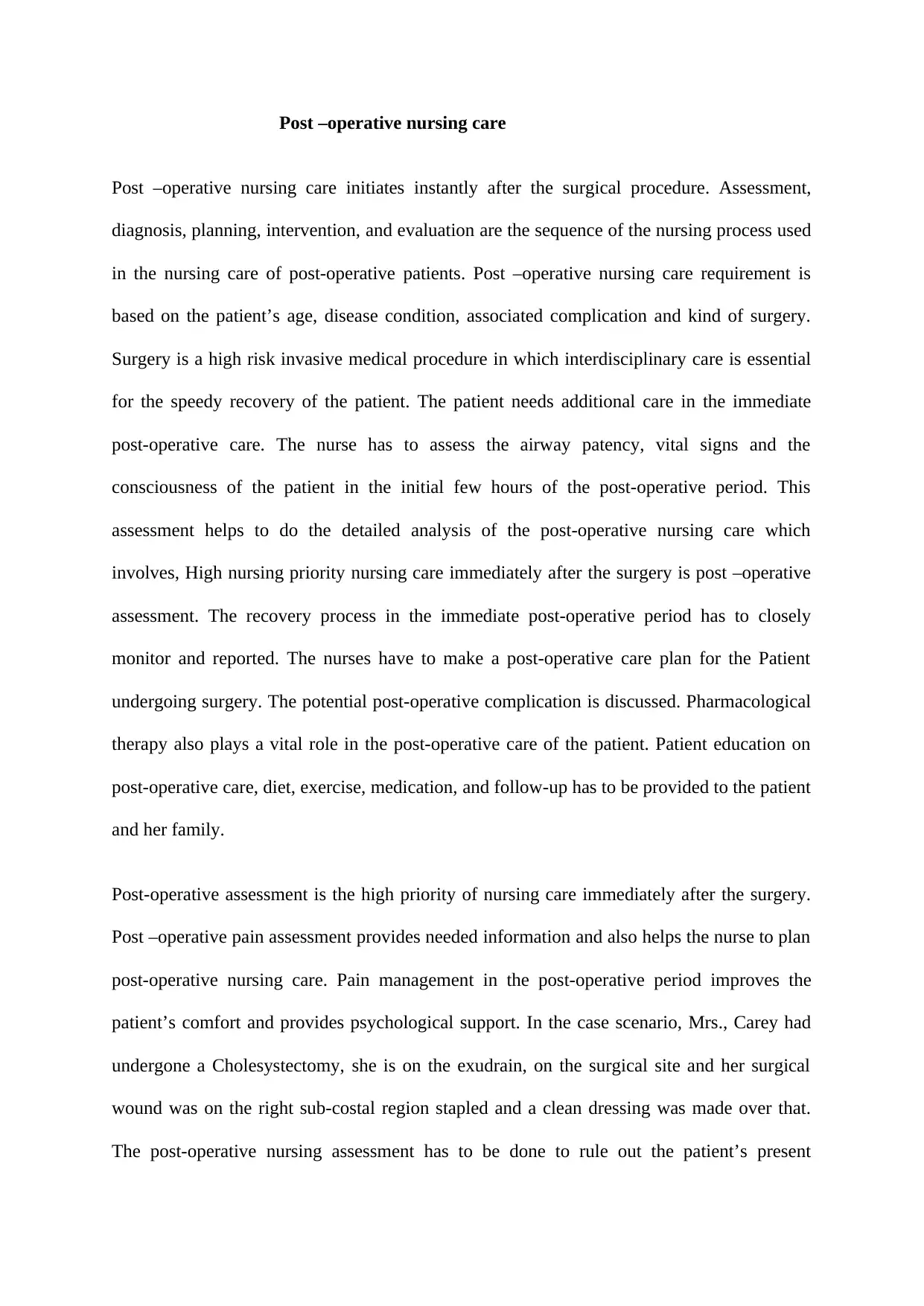
Post –operative nursing care
Post –operative nursing care initiates instantly after the surgical procedure. Assessment,
diagnosis, planning, intervention, and evaluation are the sequence of the nursing process used
in the nursing care of post-operative patients. Post –operative nursing care requirement is
based on the patient’s age, disease condition, associated complication and kind of surgery.
Surgery is a high risk invasive medical procedure in which interdisciplinary care is essential
for the speedy recovery of the patient. The patient needs additional care in the immediate
post-operative care. The nurse has to assess the airway patency, vital signs and the
consciousness of the patient in the initial few hours of the post-operative period. This
assessment helps to do the detailed analysis of the post-operative nursing care which
involves, High nursing priority nursing care immediately after the surgery is post –operative
assessment. The recovery process in the immediate post-operative period has to closely
monitor and reported. The nurses have to make a post-operative care plan for the Patient
undergoing surgery. The potential post-operative complication is discussed. Pharmacological
therapy also plays a vital role in the post-operative care of the patient. Patient education on
post-operative care, diet, exercise, medication, and follow-up has to be provided to the patient
and her family.
Post-operative assessment is the high priority of nursing care immediately after the surgery.
Post –operative pain assessment provides needed information and also helps the nurse to plan
post-operative nursing care. Pain management in the post-operative period improves the
patient’s comfort and provides psychological support. In the case scenario, Mrs., Carey had
undergone a Cholesystectomy, she is on the exudrain, on the surgical site and her surgical
wound was on the right sub-costal region stapled and a clean dressing was made over that.
The post-operative nursing assessment has to be done to rule out the patient’s present
Post –operative nursing care initiates instantly after the surgical procedure. Assessment,
diagnosis, planning, intervention, and evaluation are the sequence of the nursing process used
in the nursing care of post-operative patients. Post –operative nursing care requirement is
based on the patient’s age, disease condition, associated complication and kind of surgery.
Surgery is a high risk invasive medical procedure in which interdisciplinary care is essential
for the speedy recovery of the patient. The patient needs additional care in the immediate
post-operative care. The nurse has to assess the airway patency, vital signs and the
consciousness of the patient in the initial few hours of the post-operative period. This
assessment helps to do the detailed analysis of the post-operative nursing care which
involves, High nursing priority nursing care immediately after the surgery is post –operative
assessment. The recovery process in the immediate post-operative period has to closely
monitor and reported. The nurses have to make a post-operative care plan for the Patient
undergoing surgery. The potential post-operative complication is discussed. Pharmacological
therapy also plays a vital role in the post-operative care of the patient. Patient education on
post-operative care, diet, exercise, medication, and follow-up has to be provided to the patient
and her family.
Post-operative assessment is the high priority of nursing care immediately after the surgery.
Post –operative pain assessment provides needed information and also helps the nurse to plan
post-operative nursing care. Pain management in the post-operative period improves the
patient’s comfort and provides psychological support. In the case scenario, Mrs., Carey had
undergone a Cholesystectomy, she is on the exudrain, on the surgical site and her surgical
wound was on the right sub-costal region stapled and a clean dressing was made over that.
The post-operative nursing assessment has to be done to rule out the patient’s present
Paraphrase This Document
Need a fresh take? Get an instant paraphrase of this document with our AI Paraphraser
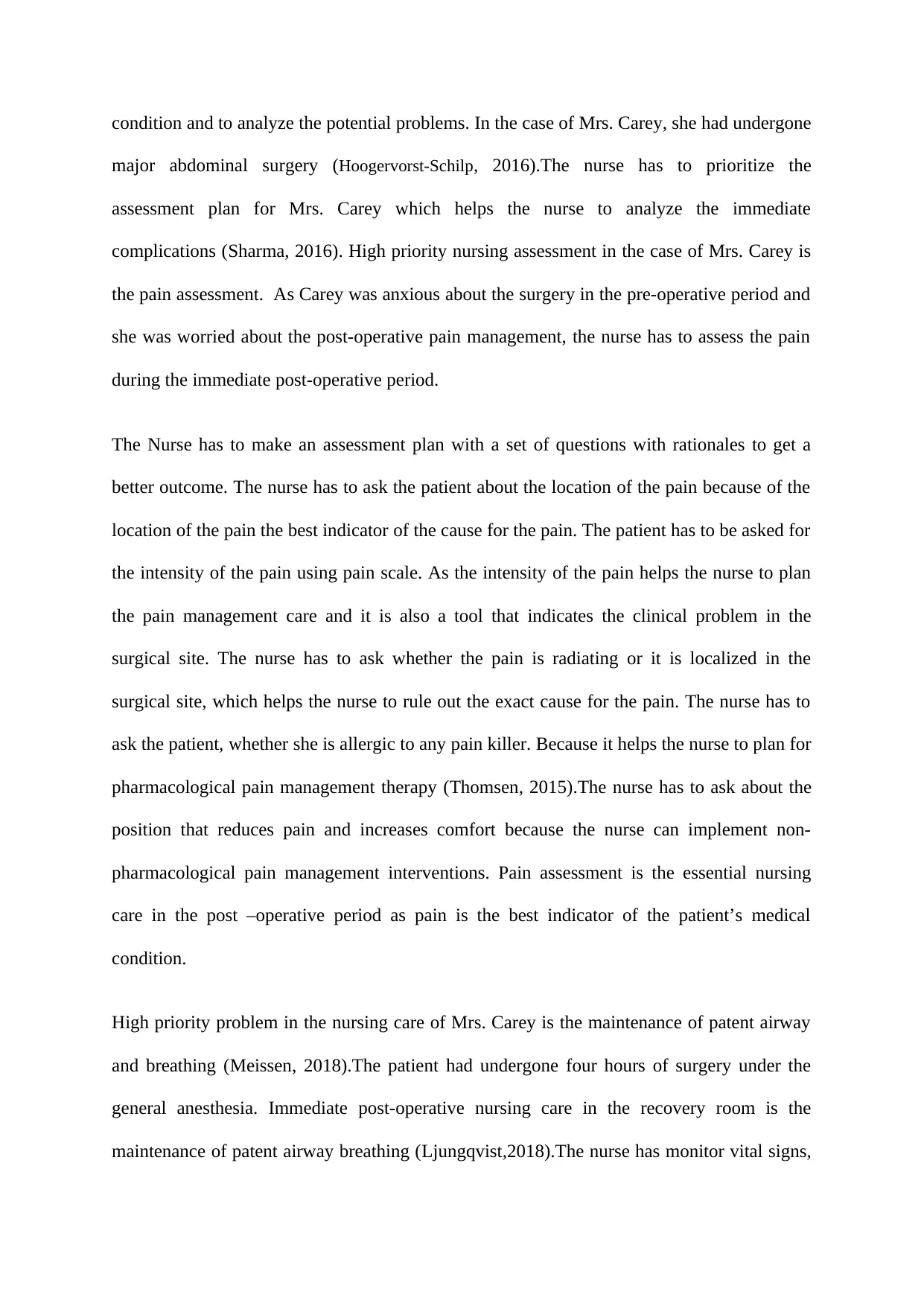
condition and to analyze the potential problems. In the case of Mrs. Carey, she had undergone
major abdominal surgery (Hoogervorst-Schilp, 2016).The nurse has to prioritize the
assessment plan for Mrs. Carey which helps the nurse to analyze the immediate
complications (Sharma, 2016). High priority nursing assessment in the case of Mrs. Carey is
the pain assessment. As Carey was anxious about the surgery in the pre-operative period and
she was worried about the post-operative pain management, the nurse has to assess the pain
during the immediate post-operative period.
The Nurse has to make an assessment plan with a set of questions with rationales to get a
better outcome. The nurse has to ask the patient about the location of the pain because of the
location of the pain the best indicator of the cause for the pain. The patient has to be asked for
the intensity of the pain using pain scale. As the intensity of the pain helps the nurse to plan
the pain management care and it is also a tool that indicates the clinical problem in the
surgical site. The nurse has to ask whether the pain is radiating or it is localized in the
surgical site, which helps the nurse to rule out the exact cause for the pain. The nurse has to
ask the patient, whether she is allergic to any pain killer. Because it helps the nurse to plan for
pharmacological pain management therapy (Thomsen, 2015).The nurse has to ask about the
position that reduces pain and increases comfort because the nurse can implement non-
pharmacological pain management interventions. Pain assessment is the essential nursing
care in the post –operative period as pain is the best indicator of the patient’s medical
condition.
High priority problem in the nursing care of Mrs. Carey is the maintenance of patent airway
and breathing (Meissen, 2018).The patient had undergone four hours of surgery under the
general anesthesia. Immediate post-operative nursing care in the recovery room is the
maintenance of patent airway breathing (Ljungqvist,2018).The nurse has monitor vital signs,
major abdominal surgery (Hoogervorst-Schilp, 2016).The nurse has to prioritize the
assessment plan for Mrs. Carey which helps the nurse to analyze the immediate
complications (Sharma, 2016). High priority nursing assessment in the case of Mrs. Carey is
the pain assessment. As Carey was anxious about the surgery in the pre-operative period and
she was worried about the post-operative pain management, the nurse has to assess the pain
during the immediate post-operative period.
The Nurse has to make an assessment plan with a set of questions with rationales to get a
better outcome. The nurse has to ask the patient about the location of the pain because of the
location of the pain the best indicator of the cause for the pain. The patient has to be asked for
the intensity of the pain using pain scale. As the intensity of the pain helps the nurse to plan
the pain management care and it is also a tool that indicates the clinical problem in the
surgical site. The nurse has to ask whether the pain is radiating or it is localized in the
surgical site, which helps the nurse to rule out the exact cause for the pain. The nurse has to
ask the patient, whether she is allergic to any pain killer. Because it helps the nurse to plan for
pharmacological pain management therapy (Thomsen, 2015).The nurse has to ask about the
position that reduces pain and increases comfort because the nurse can implement non-
pharmacological pain management interventions. Pain assessment is the essential nursing
care in the post –operative period as pain is the best indicator of the patient’s medical
condition.
High priority problem in the nursing care of Mrs. Carey is the maintenance of patent airway
and breathing (Meissen, 2018).The patient had undergone four hours of surgery under the
general anesthesia. Immediate post-operative nursing care in the recovery room is the
maintenance of patent airway breathing (Ljungqvist,2018).The nurse has monitor vital signs,
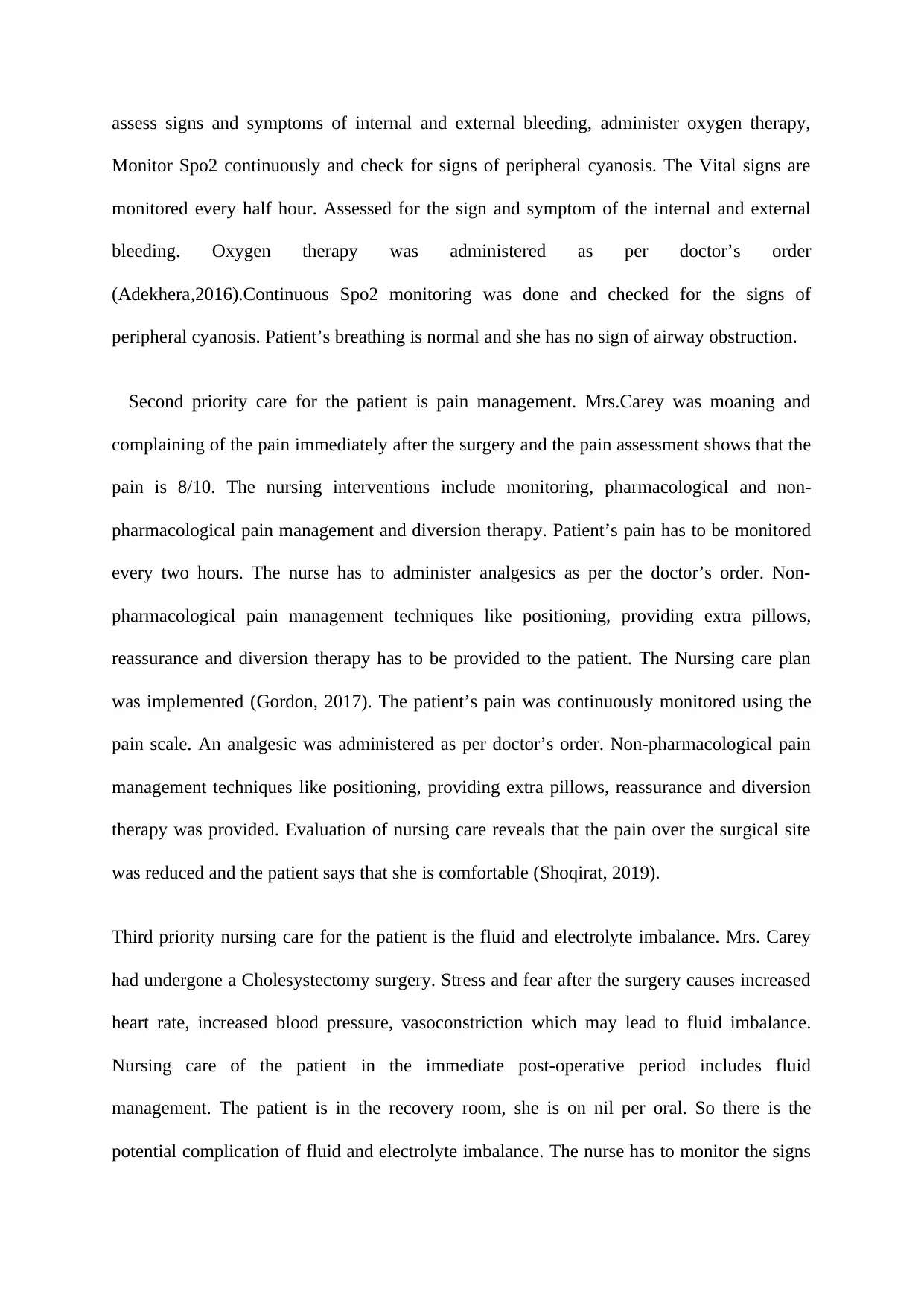
assess signs and symptoms of internal and external bleeding, administer oxygen therapy,
Monitor Spo2 continuously and check for signs of peripheral cyanosis. The Vital signs are
monitored every half hour. Assessed for the sign and symptom of the internal and external
bleeding. Oxygen therapy was administered as per doctor’s order
(Adekhera,2016).Continuous Spo2 monitoring was done and checked for the signs of
peripheral cyanosis. Patient’s breathing is normal and she has no sign of airway obstruction.
Second priority care for the patient is pain management. Mrs.Carey was moaning and
complaining of the pain immediately after the surgery and the pain assessment shows that the
pain is 8/10. The nursing interventions include monitoring, pharmacological and non-
pharmacological pain management and diversion therapy. Patient’s pain has to be monitored
every two hours. The nurse has to administer analgesics as per the doctor’s order. Non-
pharmacological pain management techniques like positioning, providing extra pillows,
reassurance and diversion therapy has to be provided to the patient. The Nursing care plan
was implemented (Gordon, 2017). The patient’s pain was continuously monitored using the
pain scale. An analgesic was administered as per doctor’s order. Non-pharmacological pain
management techniques like positioning, providing extra pillows, reassurance and diversion
therapy was provided. Evaluation of nursing care reveals that the pain over the surgical site
was reduced and the patient says that she is comfortable (Shoqirat, 2019).
Third priority nursing care for the patient is the fluid and electrolyte imbalance. Mrs. Carey
had undergone a Cholesystectomy surgery. Stress and fear after the surgery causes increased
heart rate, increased blood pressure, vasoconstriction which may lead to fluid imbalance.
Nursing care of the patient in the immediate post-operative period includes fluid
management. The patient is in the recovery room, she is on nil per oral. So there is the
potential complication of fluid and electrolyte imbalance. The nurse has to monitor the signs
Monitor Spo2 continuously and check for signs of peripheral cyanosis. The Vital signs are
monitored every half hour. Assessed for the sign and symptom of the internal and external
bleeding. Oxygen therapy was administered as per doctor’s order
(Adekhera,2016).Continuous Spo2 monitoring was done and checked for the signs of
peripheral cyanosis. Patient’s breathing is normal and she has no sign of airway obstruction.
Second priority care for the patient is pain management. Mrs.Carey was moaning and
complaining of the pain immediately after the surgery and the pain assessment shows that the
pain is 8/10. The nursing interventions include monitoring, pharmacological and non-
pharmacological pain management and diversion therapy. Patient’s pain has to be monitored
every two hours. The nurse has to administer analgesics as per the doctor’s order. Non-
pharmacological pain management techniques like positioning, providing extra pillows,
reassurance and diversion therapy has to be provided to the patient. The Nursing care plan
was implemented (Gordon, 2017). The patient’s pain was continuously monitored using the
pain scale. An analgesic was administered as per doctor’s order. Non-pharmacological pain
management techniques like positioning, providing extra pillows, reassurance and diversion
therapy was provided. Evaluation of nursing care reveals that the pain over the surgical site
was reduced and the patient says that she is comfortable (Shoqirat, 2019).
Third priority nursing care for the patient is the fluid and electrolyte imbalance. Mrs. Carey
had undergone a Cholesystectomy surgery. Stress and fear after the surgery causes increased
heart rate, increased blood pressure, vasoconstriction which may lead to fluid imbalance.
Nursing care of the patient in the immediate post-operative period includes fluid
management. The patient is in the recovery room, she is on nil per oral. So there is the
potential complication of fluid and electrolyte imbalance. The nurse has to monitor the signs
⊘ This is a preview!⊘
Do you want full access?
Subscribe today to unlock all pages.

Trusted by 1+ million students worldwide
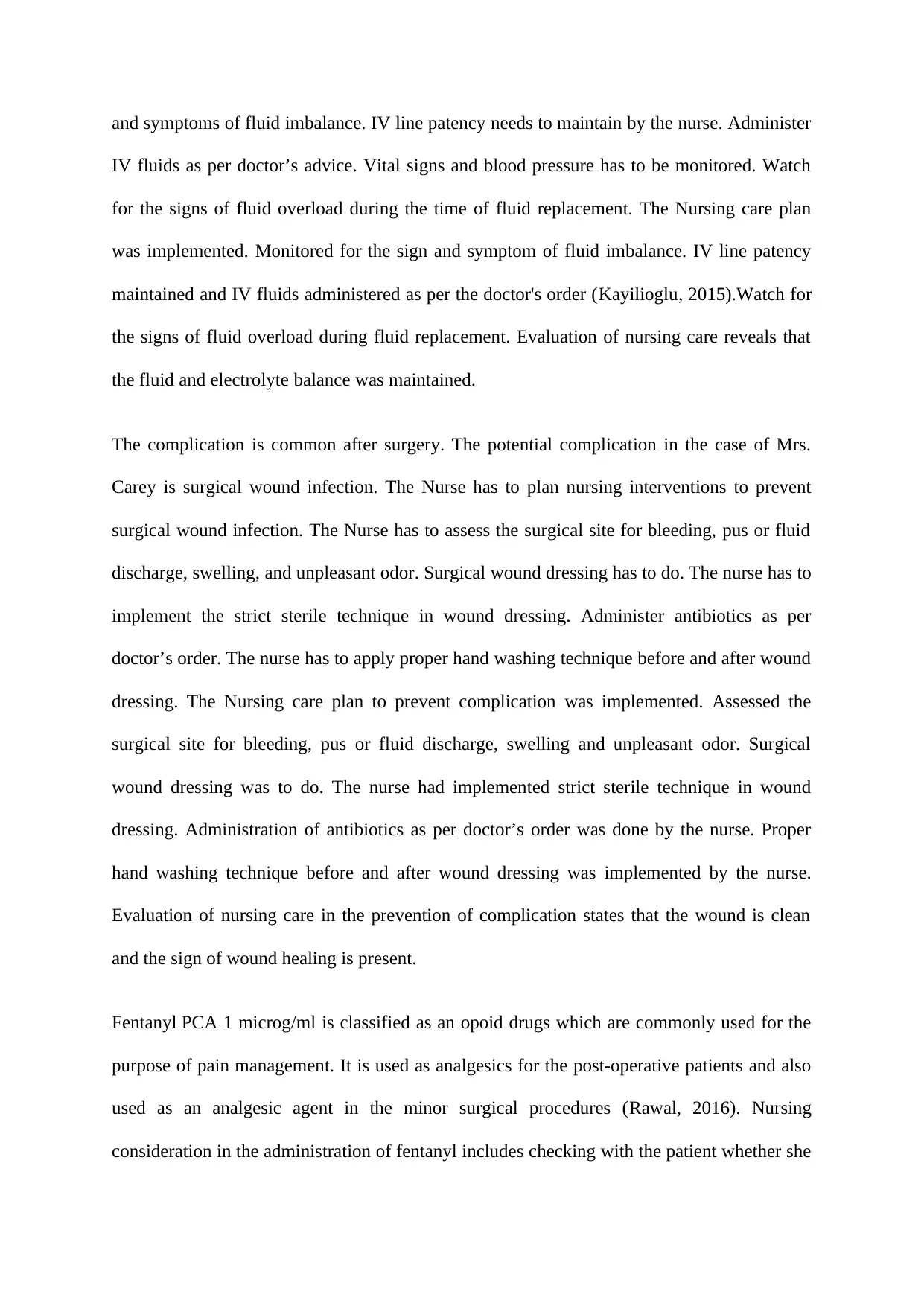
and symptoms of fluid imbalance. IV line patency needs to maintain by the nurse. Administer
IV fluids as per doctor’s advice. Vital signs and blood pressure has to be monitored. Watch
for the signs of fluid overload during the time of fluid replacement. The Nursing care plan
was implemented. Monitored for the sign and symptom of fluid imbalance. IV line patency
maintained and IV fluids administered as per the doctor's order (Kayilioglu, 2015).Watch for
the signs of fluid overload during fluid replacement. Evaluation of nursing care reveals that
the fluid and electrolyte balance was maintained.
The complication is common after surgery. The potential complication in the case of Mrs.
Carey is surgical wound infection. The Nurse has to plan nursing interventions to prevent
surgical wound infection. The Nurse has to assess the surgical site for bleeding, pus or fluid
discharge, swelling, and unpleasant odor. Surgical wound dressing has to do. The nurse has to
implement the strict sterile technique in wound dressing. Administer antibiotics as per
doctor’s order. The nurse has to apply proper hand washing technique before and after wound
dressing. The Nursing care plan to prevent complication was implemented. Assessed the
surgical site for bleeding, pus or fluid discharge, swelling and unpleasant odor. Surgical
wound dressing was to do. The nurse had implemented strict sterile technique in wound
dressing. Administration of antibiotics as per doctor’s order was done by the nurse. Proper
hand washing technique before and after wound dressing was implemented by the nurse.
Evaluation of nursing care in the prevention of complication states that the wound is clean
and the sign of wound healing is present.
Fentanyl PCA 1 microg/ml is classified as an opoid drugs which are commonly used for the
purpose of pain management. It is used as analgesics for the post-operative patients and also
used as an analgesic agent in the minor surgical procedures (Rawal, 2016). Nursing
consideration in the administration of fentanyl includes checking with the patient whether she
IV fluids as per doctor’s advice. Vital signs and blood pressure has to be monitored. Watch
for the signs of fluid overload during the time of fluid replacement. The Nursing care plan
was implemented. Monitored for the sign and symptom of fluid imbalance. IV line patency
maintained and IV fluids administered as per the doctor's order (Kayilioglu, 2015).Watch for
the signs of fluid overload during fluid replacement. Evaluation of nursing care reveals that
the fluid and electrolyte balance was maintained.
The complication is common after surgery. The potential complication in the case of Mrs.
Carey is surgical wound infection. The Nurse has to plan nursing interventions to prevent
surgical wound infection. The Nurse has to assess the surgical site for bleeding, pus or fluid
discharge, swelling, and unpleasant odor. Surgical wound dressing has to do. The nurse has to
implement the strict sterile technique in wound dressing. Administer antibiotics as per
doctor’s order. The nurse has to apply proper hand washing technique before and after wound
dressing. The Nursing care plan to prevent complication was implemented. Assessed the
surgical site for bleeding, pus or fluid discharge, swelling and unpleasant odor. Surgical
wound dressing was to do. The nurse had implemented strict sterile technique in wound
dressing. Administration of antibiotics as per doctor’s order was done by the nurse. Proper
hand washing technique before and after wound dressing was implemented by the nurse.
Evaluation of nursing care in the prevention of complication states that the wound is clean
and the sign of wound healing is present.
Fentanyl PCA 1 microg/ml is classified as an opoid drugs which are commonly used for the
purpose of pain management. It is used as analgesics for the post-operative patients and also
used as an analgesic agent in the minor surgical procedures (Rawal, 2016). Nursing
consideration in the administration of fentanyl includes checking with the patient whether she
Paraphrase This Document
Need a fresh take? Get an instant paraphrase of this document with our AI Paraphraser
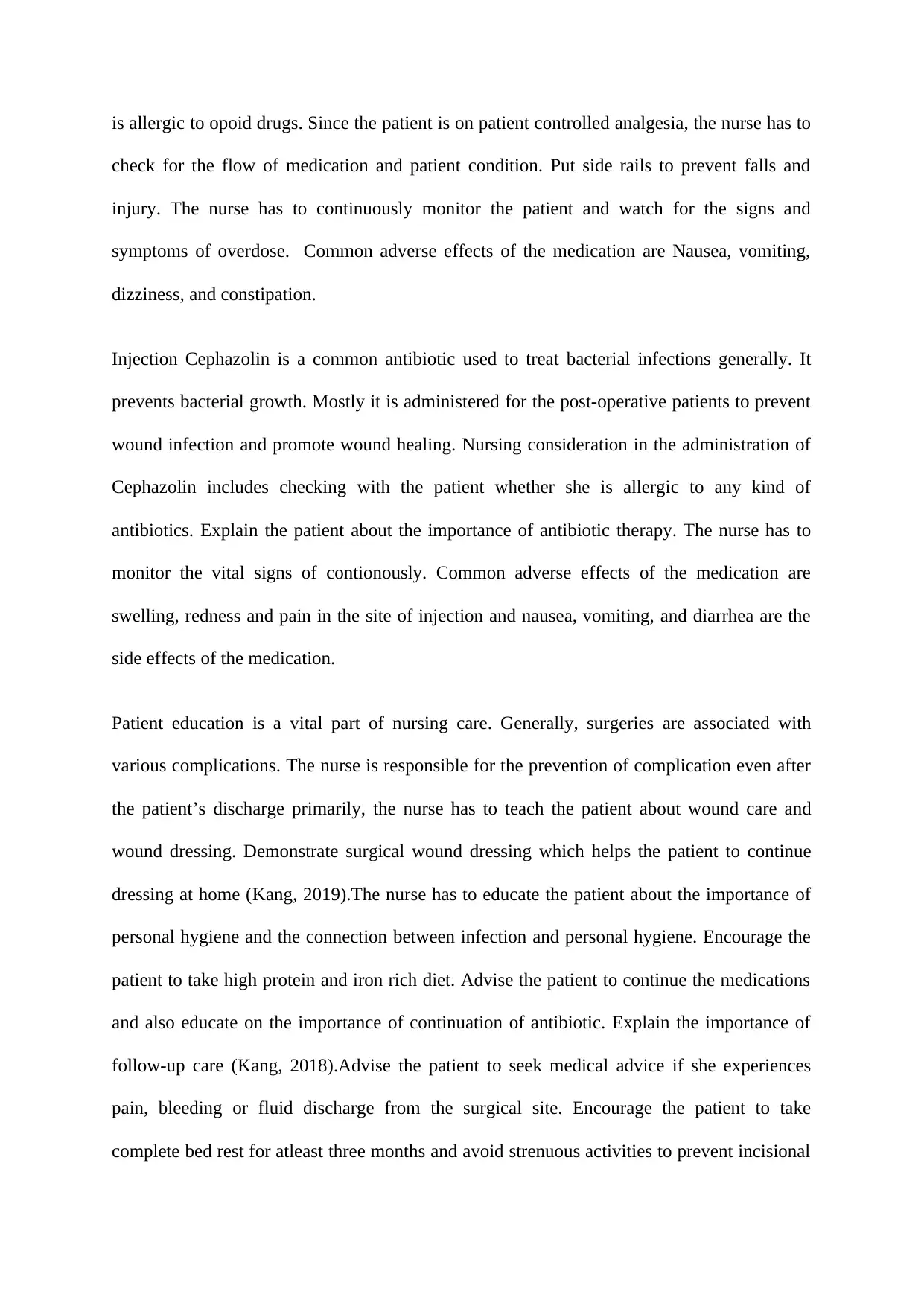
is allergic to opoid drugs. Since the patient is on patient controlled analgesia, the nurse has to
check for the flow of medication and patient condition. Put side rails to prevent falls and
injury. The nurse has to continuously monitor the patient and watch for the signs and
symptoms of overdose. Common adverse effects of the medication are Nausea, vomiting,
dizziness, and constipation.
Injection Cephazolin is a common antibiotic used to treat bacterial infections generally. It
prevents bacterial growth. Mostly it is administered for the post-operative patients to prevent
wound infection and promote wound healing. Nursing consideration in the administration of
Cephazolin includes checking with the patient whether she is allergic to any kind of
antibiotics. Explain the patient about the importance of antibiotic therapy. The nurse has to
monitor the vital signs of contionously. Common adverse effects of the medication are
swelling, redness and pain in the site of injection and nausea, vomiting, and diarrhea are the
side effects of the medication.
Patient education is a vital part of nursing care. Generally, surgeries are associated with
various complications. The nurse is responsible for the prevention of complication even after
the patient’s discharge primarily, the nurse has to teach the patient about wound care and
wound dressing. Demonstrate surgical wound dressing which helps the patient to continue
dressing at home (Kang, 2019).The nurse has to educate the patient about the importance of
personal hygiene and the connection between infection and personal hygiene. Encourage the
patient to take high protein and iron rich diet. Advise the patient to continue the medications
and also educate on the importance of continuation of antibiotic. Explain the importance of
follow-up care (Kang, 2018).Advise the patient to seek medical advice if she experiences
pain, bleeding or fluid discharge from the surgical site. Encourage the patient to take
complete bed rest for atleast three months and avoid strenuous activities to prevent incisional
check for the flow of medication and patient condition. Put side rails to prevent falls and
injury. The nurse has to continuously monitor the patient and watch for the signs and
symptoms of overdose. Common adverse effects of the medication are Nausea, vomiting,
dizziness, and constipation.
Injection Cephazolin is a common antibiotic used to treat bacterial infections generally. It
prevents bacterial growth. Mostly it is administered for the post-operative patients to prevent
wound infection and promote wound healing. Nursing consideration in the administration of
Cephazolin includes checking with the patient whether she is allergic to any kind of
antibiotics. Explain the patient about the importance of antibiotic therapy. The nurse has to
monitor the vital signs of contionously. Common adverse effects of the medication are
swelling, redness and pain in the site of injection and nausea, vomiting, and diarrhea are the
side effects of the medication.
Patient education is a vital part of nursing care. Generally, surgeries are associated with
various complications. The nurse is responsible for the prevention of complication even after
the patient’s discharge primarily, the nurse has to teach the patient about wound care and
wound dressing. Demonstrate surgical wound dressing which helps the patient to continue
dressing at home (Kang, 2019).The nurse has to educate the patient about the importance of
personal hygiene and the connection between infection and personal hygiene. Encourage the
patient to take high protein and iron rich diet. Advise the patient to continue the medications
and also educate on the importance of continuation of antibiotic. Explain the importance of
follow-up care (Kang, 2018).Advise the patient to seek medical advice if she experiences
pain, bleeding or fluid discharge from the surgical site. Encourage the patient to take
complete bed rest for atleast three months and avoid strenuous activities to prevent incisional
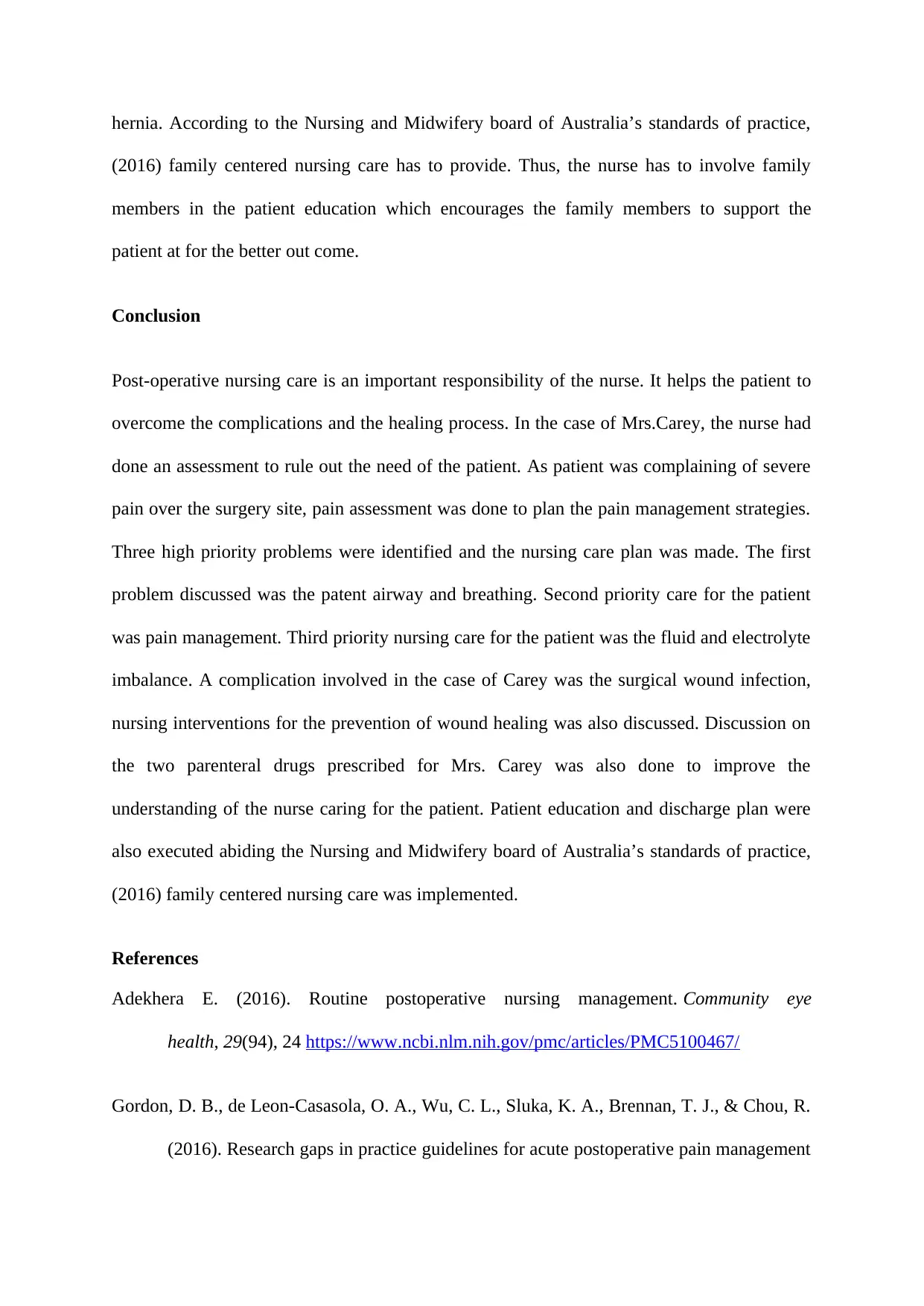
hernia. According to the Nursing and Midwifery board of Australia’s standards of practice,
(2016) family centered nursing care has to provide. Thus, the nurse has to involve family
members in the patient education which encourages the family members to support the
patient at for the better out come.
Conclusion
Post-operative nursing care is an important responsibility of the nurse. It helps the patient to
overcome the complications and the healing process. In the case of Mrs.Carey, the nurse had
done an assessment to rule out the need of the patient. As patient was complaining of severe
pain over the surgery site, pain assessment was done to plan the pain management strategies.
Three high priority problems were identified and the nursing care plan was made. The first
problem discussed was the patent airway and breathing. Second priority care for the patient
was pain management. Third priority nursing care for the patient was the fluid and electrolyte
imbalance. A complication involved in the case of Carey was the surgical wound infection,
nursing interventions for the prevention of wound healing was also discussed. Discussion on
the two parenteral drugs prescribed for Mrs. Carey was also done to improve the
understanding of the nurse caring for the patient. Patient education and discharge plan were
also executed abiding the Nursing and Midwifery board of Australia’s standards of practice,
(2016) family centered nursing care was implemented.
References
Adekhera E. (2016). Routine postoperative nursing management. Community eye
health, 29(94), 24 https://www.ncbi.nlm.nih.gov/pmc/articles/PMC5100467/
Gordon, D. B., de Leon-Casasola, O. A., Wu, C. L., Sluka, K. A., Brennan, T. J., & Chou, R.
(2016). Research gaps in practice guidelines for acute postoperative pain management
(2016) family centered nursing care has to provide. Thus, the nurse has to involve family
members in the patient education which encourages the family members to support the
patient at for the better out come.
Conclusion
Post-operative nursing care is an important responsibility of the nurse. It helps the patient to
overcome the complications and the healing process. In the case of Mrs.Carey, the nurse had
done an assessment to rule out the need of the patient. As patient was complaining of severe
pain over the surgery site, pain assessment was done to plan the pain management strategies.
Three high priority problems were identified and the nursing care plan was made. The first
problem discussed was the patent airway and breathing. Second priority care for the patient
was pain management. Third priority nursing care for the patient was the fluid and electrolyte
imbalance. A complication involved in the case of Carey was the surgical wound infection,
nursing interventions for the prevention of wound healing was also discussed. Discussion on
the two parenteral drugs prescribed for Mrs. Carey was also done to improve the
understanding of the nurse caring for the patient. Patient education and discharge plan were
also executed abiding the Nursing and Midwifery board of Australia’s standards of practice,
(2016) family centered nursing care was implemented.
References
Adekhera E. (2016). Routine postoperative nursing management. Community eye
health, 29(94), 24 https://www.ncbi.nlm.nih.gov/pmc/articles/PMC5100467/
Gordon, D. B., de Leon-Casasola, O. A., Wu, C. L., Sluka, K. A., Brennan, T. J., & Chou, R.
(2016). Research gaps in practice guidelines for acute postoperative pain management
⊘ This is a preview!⊘
Do you want full access?
Subscribe today to unlock all pages.

Trusted by 1+ million students worldwide
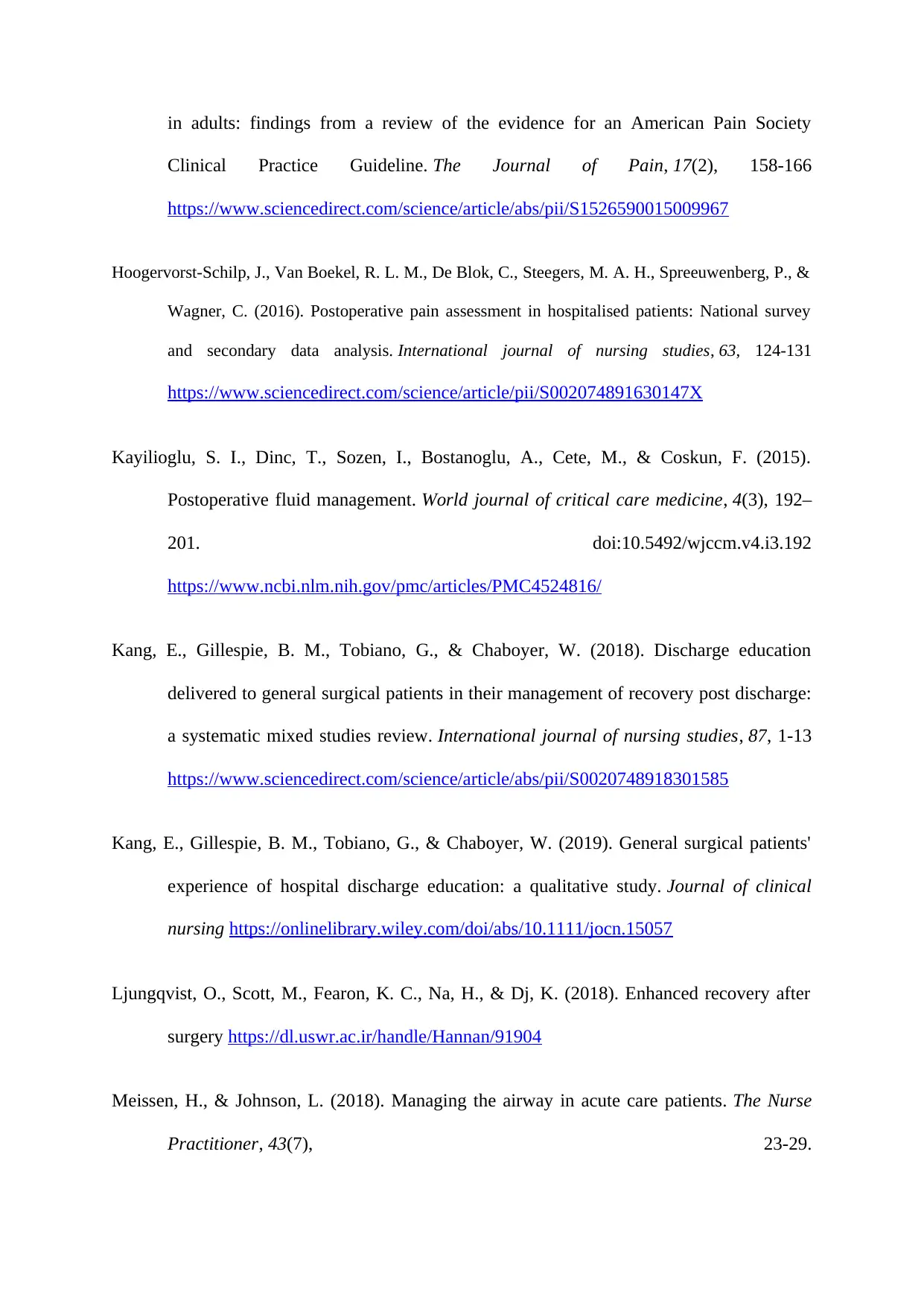
in adults: findings from a review of the evidence for an American Pain Society
Clinical Practice Guideline. The Journal of Pain, 17(2), 158-166
https://www.sciencedirect.com/science/article/abs/pii/S1526590015009967
Hoogervorst-Schilp, J., Van Boekel, R. L. M., De Blok, C., Steegers, M. A. H., Spreeuwenberg, P., &
Wagner, C. (2016). Postoperative pain assessment in hospitalised patients: National survey
and secondary data analysis. International journal of nursing studies, 63, 124-131
https://www.sciencedirect.com/science/article/pii/S002074891630147X
Kayilioglu, S. I., Dinc, T., Sozen, I., Bostanoglu, A., Cete, M., & Coskun, F. (2015).
Postoperative fluid management. World journal of critical care medicine, 4(3), 192–
201. doi:10.5492/wjccm.v4.i3.192
https://www.ncbi.nlm.nih.gov/pmc/articles/PMC4524816/
Kang, E., Gillespie, B. M., Tobiano, G., & Chaboyer, W. (2018). Discharge education
delivered to general surgical patients in their management of recovery post discharge:
a systematic mixed studies review. International journal of nursing studies, 87, 1-13
https://www.sciencedirect.com/science/article/abs/pii/S0020748918301585
Kang, E., Gillespie, B. M., Tobiano, G., & Chaboyer, W. (2019). General surgical patients'
experience of hospital discharge education: a qualitative study. Journal of clinical
nursing https://onlinelibrary.wiley.com/doi/abs/10.1111/jocn.15057
Ljungqvist, O., Scott, M., Fearon, K. C., Na, H., & Dj, K. (2018). Enhanced recovery after
surgery https://dl.uswr.ac.ir/handle/Hannan/91904
Meissen, H., & Johnson, L. (2018). Managing the airway in acute care patients. The Nurse
Practitioner, 43(7), 23-29.
Clinical Practice Guideline. The Journal of Pain, 17(2), 158-166
https://www.sciencedirect.com/science/article/abs/pii/S1526590015009967
Hoogervorst-Schilp, J., Van Boekel, R. L. M., De Blok, C., Steegers, M. A. H., Spreeuwenberg, P., &
Wagner, C. (2016). Postoperative pain assessment in hospitalised patients: National survey
and secondary data analysis. International journal of nursing studies, 63, 124-131
https://www.sciencedirect.com/science/article/pii/S002074891630147X
Kayilioglu, S. I., Dinc, T., Sozen, I., Bostanoglu, A., Cete, M., & Coskun, F. (2015).
Postoperative fluid management. World journal of critical care medicine, 4(3), 192–
201. doi:10.5492/wjccm.v4.i3.192
https://www.ncbi.nlm.nih.gov/pmc/articles/PMC4524816/
Kang, E., Gillespie, B. M., Tobiano, G., & Chaboyer, W. (2018). Discharge education
delivered to general surgical patients in their management of recovery post discharge:
a systematic mixed studies review. International journal of nursing studies, 87, 1-13
https://www.sciencedirect.com/science/article/abs/pii/S0020748918301585
Kang, E., Gillespie, B. M., Tobiano, G., & Chaboyer, W. (2019). General surgical patients'
experience of hospital discharge education: a qualitative study. Journal of clinical
nursing https://onlinelibrary.wiley.com/doi/abs/10.1111/jocn.15057
Ljungqvist, O., Scott, M., Fearon, K. C., Na, H., & Dj, K. (2018). Enhanced recovery after
surgery https://dl.uswr.ac.ir/handle/Hannan/91904
Meissen, H., & Johnson, L. (2018). Managing the airway in acute care patients. The Nurse
Practitioner, 43(7), 23-29.
Paraphrase This Document
Need a fresh take? Get an instant paraphrase of this document with our AI Paraphraser
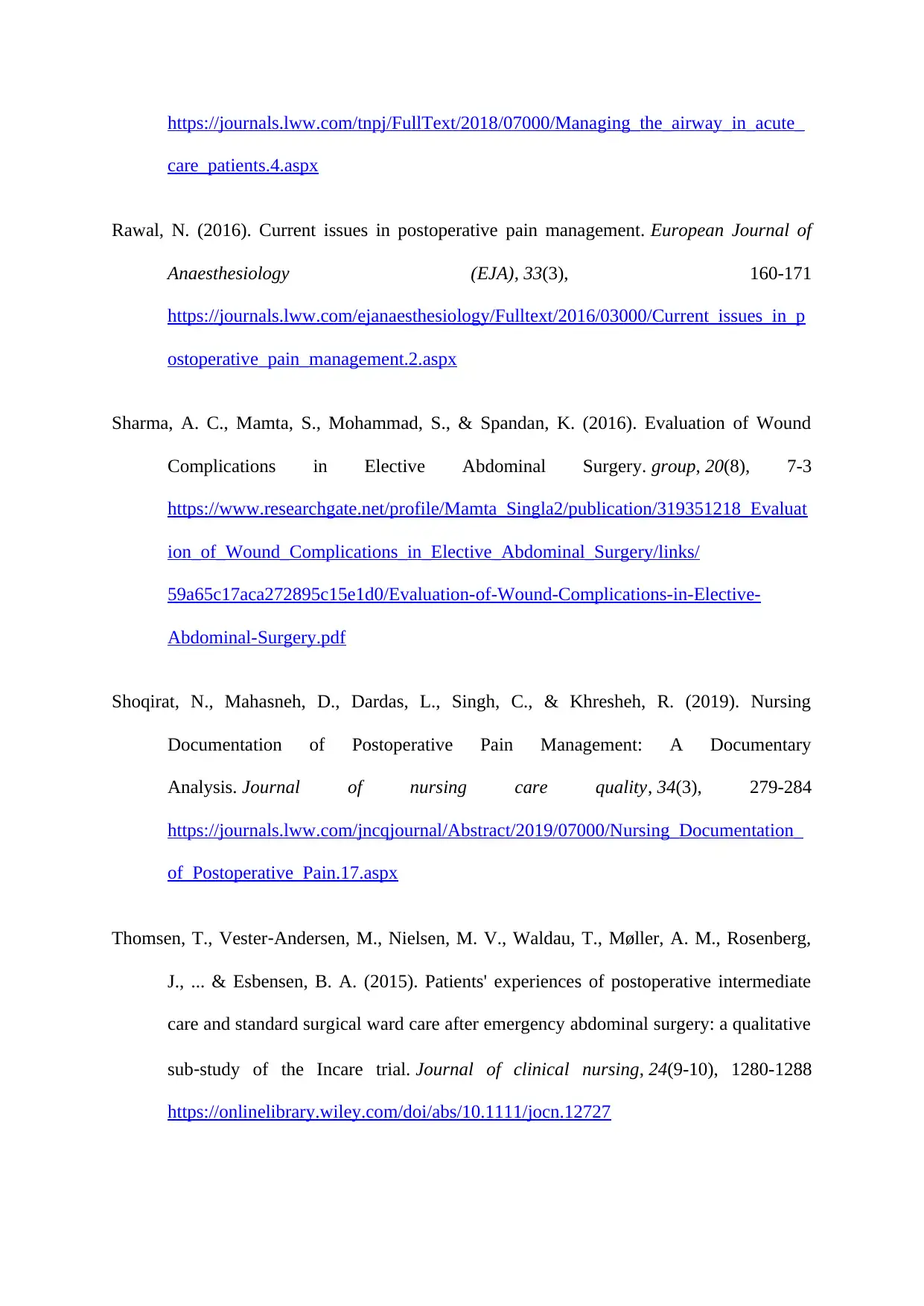
https://journals.lww.com/tnpj/FullText/2018/07000/Managing_the_airway_in_acute_
care_patients.4.aspx
Rawal, N. (2016). Current issues in postoperative pain management. European Journal of
Anaesthesiology (EJA), 33(3), 160-171
https://journals.lww.com/ejanaesthesiology/Fulltext/2016/03000/Current_issues_in_p
ostoperative_pain_management.2.aspx
Sharma, A. C., Mamta, S., Mohammad, S., & Spandan, K. (2016). Evaluation of Wound
Complications in Elective Abdominal Surgery. group, 20(8), 7-3
https://www.researchgate.net/profile/Mamta_Singla2/publication/319351218_Evaluat
ion_of_Wound_Complications_in_Elective_Abdominal_Surgery/links/
59a65c17aca272895c15e1d0/Evaluation-of-Wound-Complications-in-Elective-
Abdominal-Surgery.pdf
Shoqirat, N., Mahasneh, D., Dardas, L., Singh, C., & Khresheh, R. (2019). Nursing
Documentation of Postoperative Pain Management: A Documentary
Analysis. Journal of nursing care quality, 34(3), 279-284
https://journals.lww.com/jncqjournal/Abstract/2019/07000/Nursing_Documentation_
of_Postoperative_Pain.17.aspx
Thomsen, T., Vester‐Andersen, M., Nielsen, M. V., Waldau, T., Møller, A. M., Rosenberg,
J., ... & Esbensen, B. A. (2015). Patients' experiences of postoperative intermediate
care and standard surgical ward care after emergency abdominal surgery: a qualitative
sub‐study of the Incare trial. Journal of clinical nursing, 24(9-10), 1280-1288
https://onlinelibrary.wiley.com/doi/abs/10.1111/jocn.12727
care_patients.4.aspx
Rawal, N. (2016). Current issues in postoperative pain management. European Journal of
Anaesthesiology (EJA), 33(3), 160-171
https://journals.lww.com/ejanaesthesiology/Fulltext/2016/03000/Current_issues_in_p
ostoperative_pain_management.2.aspx
Sharma, A. C., Mamta, S., Mohammad, S., & Spandan, K. (2016). Evaluation of Wound
Complications in Elective Abdominal Surgery. group, 20(8), 7-3
https://www.researchgate.net/profile/Mamta_Singla2/publication/319351218_Evaluat
ion_of_Wound_Complications_in_Elective_Abdominal_Surgery/links/
59a65c17aca272895c15e1d0/Evaluation-of-Wound-Complications-in-Elective-
Abdominal-Surgery.pdf
Shoqirat, N., Mahasneh, D., Dardas, L., Singh, C., & Khresheh, R. (2019). Nursing
Documentation of Postoperative Pain Management: A Documentary
Analysis. Journal of nursing care quality, 34(3), 279-284
https://journals.lww.com/jncqjournal/Abstract/2019/07000/Nursing_Documentation_
of_Postoperative_Pain.17.aspx
Thomsen, T., Vester‐Andersen, M., Nielsen, M. V., Waldau, T., Møller, A. M., Rosenberg,
J., ... & Esbensen, B. A. (2015). Patients' experiences of postoperative intermediate
care and standard surgical ward care after emergency abdominal surgery: a qualitative
sub‐study of the Incare trial. Journal of clinical nursing, 24(9-10), 1280-1288
https://onlinelibrary.wiley.com/doi/abs/10.1111/jocn.12727

⊘ This is a preview!⊘
Do you want full access?
Subscribe today to unlock all pages.

Trusted by 1+ million students worldwide
1 out of 9
Related Documents
Your All-in-One AI-Powered Toolkit for Academic Success.
+13062052269
info@desklib.com
Available 24*7 on WhatsApp / Email
![[object Object]](/_next/static/media/star-bottom.7253800d.svg)
Unlock your academic potential
Copyright © 2020–2025 A2Z Services. All Rights Reserved. Developed and managed by ZUCOL.





